Dell XPS 15 2-in-1 (9575) review: A powerhouse convertible with only a few sacrifices
Dell's new XPS 15 (9575) merges a convertible with its juggernaut 15-inch laptop for the first time. Here's what works, and what doesn't.


For the last couple of years, few laptops have caught as much attention as Dell's flagship XPS 15. The juggernaut 15.6-inch laptop is one of the ultimate all-around Windows 10 PCs that balanced good battery life, ports, with sheer power.
But there was one problem. While the XPS 15 had a touch screen, it lacked pen support, let alone the ability to act as a tablet.
That changes in 2018 with the all-new XPS 15 2-in-1 (9575). While the familiar XPS 15 (9570) remains, the new 9575 is for those who want the best of all worlds. Today we'll tell you if there are any severe compromises to this first-gen product from Dell.
Dell XPS 15 2-in-1 features and hardware
Dell said it aimed for few compromises for this 2-in-1 compared to its regular, non-transforming 9570 bigger brother. That's mostly true — the 9575 is arguably the most potent 2-in-1 PC — but there are some drawbacks too.
For processors, there are two options. The Intel i5-8305G or Core i7-8705G. Both are quad-core processors and part of Intel's new 8th generation line, but they are now coupled with AMD Radeon RX Vega M GL graphics (8MB cache, up to 4.1GHz). For this review, we had both the i5 and i7 options for testing.
These CPUs are not the familiar Ultra-low Voltage (ULV) chips found in Ultrabooks, but the more powerful 45-watt types. The AMD Radeon is a new, odd partnership with Intel, but its addition replaces the standard Intel HD graphics for a much more powerful Vega-based system to give the 9575 some extra punch.
Dell XPS 15 (9575) tech specs
| Category | Dell XPS 15 (9575) |
|---|---|
| Processor | Intel 8th Generation Core i5-8305G quad-core Intel 8th Generation Core i7-8705G quad-core |
| Display size | 15.6-inch UltraSharp 4K (3840x2160) touch display, 100% color gamut FHD (1920 x 1080) touch display, 100% color gamut 400-nits, 1500:1 contrast ratio, anti-reflective 178° wide viewing angle |
| RAM | 8GB-16GB Dual Channel DDR4 at 2400MHz (On Board) |
| Discrete graphics | Radeon RX Vega M GL graphics with 4GB HBM2 RAM |
| Ports | 2x Thunderbolt 3 with PowerShare 2x USB-C 3.1 with PowerShare microSD card reader headset jack |
| Active pen | Bluetooth 4.2 Multi-mode support including MPP (Microsoft Pen Protocol), Wacom AES1.0 and Wacom AES2.0 4,096 pressure levels |
| Storage | 128GB (SATA); 256GB, 512GB, 1TB, or 2TB (PCIe) |
| Wireless | Killer 1435 802.11ac [2x2] + Bluetooth 4.1 Intel 8265 802.11ac [2x2] wireless for vPro + Bluetooth 4.1 Miracast capable |
| Sensors | Gyroscope, eCompass/Magnetometer, Accelerometer/FFS |
| Biometric | Widescreen 720p webcam with four array digital microphones; Windows Hello compliant infrared camera; Far Field Cortana capable Optional Windows Hello compliant fingerprint reader in power button |
| Battery | 75WHr (non-user-replaceable) |
| AC Charger | 130W AC adapter |
| Weight | 4.3 lbs (1.97 kg) |
| Dimensions | 0.35 in to 0.63 in (9 mm to 16 mm) x 13.9 in (354 mm) x 9.3 in (235mm) (H x W x D) |
| Starting price | $1,299.99 |
| Availability | Spring 2018 Dell.com, Microsoft.com |
Get the Windows Central Newsletter
All the latest news, reviews, and guides for Windows and Xbox diehards.
The display comes into two options — full HD or 4K — both Sharp IGZO (Indium gallium zinc oxide) with 400-nits of brightness, anti-glare coating, touch support with a pen (Wacom), and those Infinity Edge super thin bezels. The 4K option costs a jaw-dropping $400 extra over the full HD panel. For this review, we were able to evaluate both screen types.
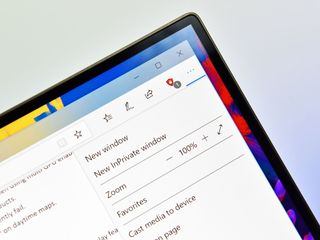
RAM starts at 8GB and can go up to 16GB both of which are DDR4-2400MHz. The RAM is "integrated," which unfortunately means it is not user upgradable because it is soldered to the board. With the Core i5 processor, you can only configure the laptop with 8GB of RAM, with 16GB reserved for Core i7 models.
Port selection is modest with four USB Type-C ports. Two of those are full Thunderbolt 3 with PowerShare, and the other two are standard USB-C 3.1 with PowerShare. Those Thunderbolt 3 ports are 4x PCIe lanes supporting external GPUs and work with the included 130W AC charger. There is also a microSD card reader and 3.5mm headset jack.
Dell XPS 15 2-in-1 (9575) – The good

The Sharp IGZO displays are outstanding. The full HD panel yields 98 percent sRGB for color accuracy (and a respectable 75 percent for Adobe RGB). The 4K screen is even better at 100 percent sRGB and 97 percent Adobe RGB. Both panels hit 400 nits and can get extremely bright especially compared to the last generation of IGZO screens.
The addition of an anti-glare coating makes eye-fatigue a thing of the past while retaining rich color and vibrancy that clear glossy displays are known for.
Touch and pen responsiveness is also enjoyable. The Wacom AES pen (sold separately) combined with the high-performance processor and AMD graphics is a joy when using Windows Ink.
Dell reinvented the keyboard for the 9575 in going with a "maglev" (magnetic levitation) design. Forgoing rubber cups this laptop uses powerful magnets to push the keys back up resulting in a slimmer profile. Good travel on a computer is at least 1.1mm, with 1.3mm being on the high-end. This keyboard is just 0.7mm, which is extremely short and — in theory — not very good.

Surprisingly, this maglev keyboard is delightful to use. There is some minor typing adjustment, but this period is measured in hours, not days. The keys are exceptionally even and consistent with first-rate actuation, making this one of the fastest keyboards for typing. It easily outdoes Apple's "butterfly switches" found in the new MacBook Pros.
The trackpad is great with a huge footprint and a smooth glass feel, all powered by Microsoft Precision Drivers.
Dell includes dual-infrared (IR) sensors near the web camera for Windows Hello and offers a fingerprint reader built into the power button giving users an option. Both worked without flaw 100 percent of the time.
Performance is a bit tricky due to the complexity of the new AMD Radeon RX Vega M GL, which shares the same single-component as the Intel Core processor, but in short, it is excellent. The Core i5-8305G model earned a Geekbench score of 4,597 for single-core and 14,253 for multi-core. That's equivalent to the highly-clocked Core i7-8550U found in Dell's XPS 13 (9370).


Pushing to the more expensive Core i7-8705G, the XPS 15 9575 measured 5,015 for single-core on Geekbench. That single-core score is like the Surface Book 2 15-inch (5,036), but Dell trounces the Surface Book 2 15-inch on multi-core — 16,094 versus Microsoft's 14,237.
Turning to the AMD Radeon RX Vega M GL and its 66,903 scores on Geekbench falls just short of the NVIDIA GTX 1050 (75,665).
The bottom line is for a 2-in-1 the XPS 15 (9575) has the better CPU compared to the Surface Book 2 15-inch, but Microsoft's PC will beat out Dell for raw graphics power. There's no shame in that, it just depends which you value more — CPU or GPU?
The overall chassis build-quality is very solid. There are no creaks or flex, and the whole laptop feels evenly balanced with no hollow points. This laptop is a tank, and it looks great too even if the silver is getting a bit tiring.
Dell XPS 15 2-in-1 (9575) – The bad

The XPS 15 (9575) may be built like a tank, but it feels it too. Of course, using the laptop in presentation-mode (keyboard folder under as the base) is still an enjoyable experience, and inking while flat on a table is also fantastic, but don't look to hold this like a Surface Pro for more than a minute or two without substantial fatigue.
That makes this 2-in-1 convertible less useful than a Lenovo X1 Yoga.
Audio — for a Dell — is quite good, but these are still dual-speakers placed on the bottom edge resulting in a more muffled sound when used in laptop mode. Volume level is decent (but not very loud) with a crispy, well-balanced audio profile. The spatial separation is also outstanding. Some of this praise shifts though when you change positions from laptop to tablet to presentation-mode to tent-mode making a very uneven experience.
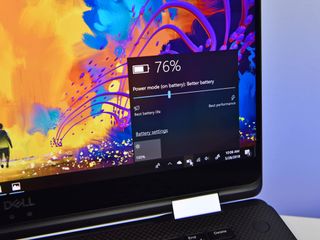
Battery life and fan noise are also not strengths. When using the Windows 10 "Better battery" (default) mode for power, the fans are quiet but turning to "Best performance" changes things quickly. Doing a Windows Update or running some intensive software will result in louder than usual fan noise for a laptop in 2018.
Temperatures also get toasty in the bottom center. While never hot for regular use under heavy load that Core i7 may get too warm for some especially when wearing shorts.
The battery life — thanks to a decently-sized 75WHr battery — depends on tasks and the chosen configuration. The Core i5 model can push 8 hours of regular laptop usage (web browsing, video, music, email, running Microsoft Store apps), but the Core i7 one will struggle to hit 6 hours, which is below most premium laptops these days and is akin to a gaming PC.

The power-hungry 4K display also hampers the Core i7 battery. Users can order the full HD display with a Core i7 processor, but Dell does not have an option for a 4K model with a Core i5 processor.
I won't belabor the under-the-display web camera, which is old news. Dell still uses this configuration to maximize those thin displays. If you use a web camera often, it will bother you, but if you barely use it then it won't.
Dell ships the XPS 15 9575 with a decent PCIe NVMe SSD, but performance is lacking for write speeds — around just 600 Mbps — which is far below premium. Luckily, read-speeds (about 2,500 Mbps) — and what users experience most of the time — is admirable. Crafty users can also upgrade storage later with a more performant SSD of their choosing.
Which configuration should you buy?
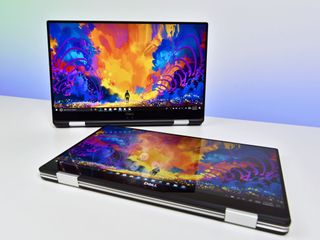
While most enthusiasts are quick to jump on the Core i7 model with a 4K display — because more is better — the Core i5 with full HD is the real value play and what I would purchase.
With a starting price of just $1,499, this is the model to get for those who want a very good experience with a Windows 10 laptop. While it "only" has 256GB of storage you can always upgrade that later — which is probably a good idea anyway since the write speeds by default are not outstanding.
I found the full HD display to be just stunning. The delta between 4K and full HD has shrunk when manufacturers don't cheap-out on the latter's quality, and that is the case here. While 4K looks sublime, it is just not as impressive anymore when both screens have so much going for them — touch, anti-glare, high brightness, and sRGB color accuracy are all identical.
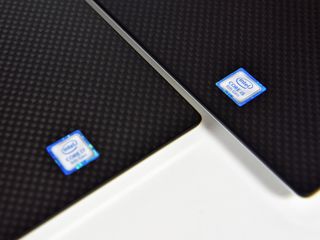
To help convince you just remember that the 4K panel is a $400 upgrade! That's insane. Combined with the required Core i7 processor that configuration starts at $2,049 making it a $750 additional investment. If you're using this as a student, light-gaming, or for casual use that model (and price) is the definition of overkill.
Of course, if your job necessitates a 4K display for video or photo editing, or you need that Core i7 processor (most do not) then you will be rewarded with a high-performant laptop that is a juggernaut – so long as you do not prioritize battery life.
XPS 15 (9575) 2-in-1: The bottom line
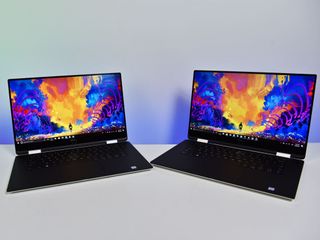
Regarding overall design, Dell did an outstanding job. This laptop is not just an old XPS 15 but now with 180-degree display hinge. The company thoughtfully designed this from the ground-up, and it works.
Performance is so good I have a tough time recommending the Core i7 model unless your job requires it. The Core i5 is like a high-end Core i7 Ultrabook, which is to say fast and responsive.
Strengths of this laptop are the fundamentals: typing, display, trackpad, and build quality. These are well-above average, and it makes using it enjoyable. Inking is also not overlooked here. The Wacom AES 2.0 with 4,096 levels of pressure is serious hardware, and it makes inking on this device exceptional.


Where the XPS 15 (9575) 2-in-1 falters is the overall size — it's large and heavy — and the battery life, which is below average. For many, that may not be a big deal where this is a laptop to take between home and work with moderate usage during a morning commute or short flight. But for those looking for something that where they can leave the (rather large) charger at home you may be disappointed.
The micro SD card reader is OK, but a full-sized reader would have worked better.
Pros:
- Best-in-class display panels.
- Outstanding CPU performance, good GPU.
- Solidly built chassis, balanced design.
- The maglev keyboard is awesome.
Cons:
- Heavy for tablet usage.
- Underwhelming battery life.
- Gets noisy under load.
- The 4K panel is very expensive.
The Killer 1435 wireless card worked well especially with the Linksys WRT32X router, which auto-prioritize traffic for this hardware.
Overall, Dell took a risk in making this laptop – it's not quite a great tablet, and it will have worse performance than the refreshed XPS 15 (9570) – but it's clever, fun to use, and it has a display that makes you want to stare at it for hours even with "just" full HD.
Any laptop that does all of that is a winner and easy to recommend.

Daniel Rubino is the Editor-in-chief of Windows Central. He is also the head reviewer, podcast co-host, and analyst. He has been covering Microsoft since 2007, when this site was called WMExperts (and later Windows Phone Central). His interests include Windows, laptops, next-gen computing, and watches. He has been reviewing laptops since 2015 and is particularly fond of 2-in-1 convertibles, ARM processors, new form factors, and thin-and-light PCs. Before all this tech stuff, he worked on a Ph.D. in linguistics, watched people sleep (for medical purposes!), and ran the projectors at movie theaters because it was fun.